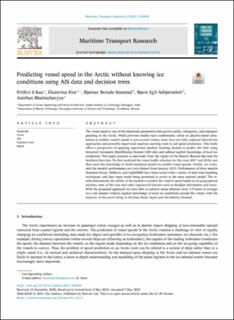| dc.contributor.author | Rao, Prithvi S. | |
| dc.contributor.author | Kim, Ekaterina | |
| dc.contributor.author | Smestad, Bjørnar Brende | |
| dc.contributor.author | Asbjørnslett, Bjørn Egil | |
| dc.contributor.author | Bhattacharyya, Anirban | |
| dc.date.accessioned | 2022-11-02T09:07:31Z | |
| dc.date.available | 2022-11-02T09:07:31Z | |
| dc.date.created | 2021-05-31T09:55:13Z | |
| dc.date.issued | 2021 | |
| dc.identifier.citation | Maritime Transport Research. 2021, 2, . | en_US |
| dc.identifier.issn | 2666-822X | |
| dc.identifier.uri | https://hdl.handle.net/11250/3029508 | |
| dc.description.abstract | The vessel speed is one of the important parameters that govern safety, emergency, and transport planning in the Arctic. While previous studies have traditionally relied on physics-based simulations to predict vessel's speed in ice-covered waters, most have not fully explored data-driven approaches and powerful supervised machine learning tools to aid speed prediction. This study offers a perspective of applying supervised machine learning models to predict MV SOG using historical Automatic Identification System (AIS) data and without explicit knowledge of local ice conditions. This paper presents a case-study from the region of the Eastern Barents Sea and the Southern Kara Sea. We first analyzed the vessel traffic situation for the years 2017 and 2018, and then used this knowledge to build statistical models to predict vessel speeds. Finally, we evaluated the models’ performance on a test dataset from January 2019. Performance of three models (Random Forest, XGBoost, and LightGBM) have been tested with a variety of date-time handling techniques, and data input mode being permuted to arrive at the most optimal model. The results demonstrate the ability of the models to predict the vessel's speed based on its geographical location, time of the year and other engineered features such as daylight information and route. With the proposed approach we were able to achieve mean absolute error 3.5 knots in average on a test dataset without explicit knowledge of local ice conditions around the vessel, with the majority of the errors being in the Kara Strait region and the Sabetta Channel. | en_US |
| dc.language.iso | eng | en_US |
| dc.publisher | Elsevier Science | en_US |
| dc.rights | Navngivelse 4.0 Internasjonal | * |
| dc.rights.uri | http://creativecommons.org/licenses/by/4.0/deed.no | * |
| dc.subject | Maskinlæring | en_US |
| dc.subject | Machine learning | en_US |
| dc.subject | Skipsfart | en_US |
| dc.subject | Shipping | en_US |
| dc.subject | Arktis | en_US |
| dc.subject | Arctic | en_US |
| dc.title | Predicting vessel speed in the Arctic without knowing ice conditions using AIS data and decision trees | en_US |
| dc.title.alternative | Predicting vessel speed in the Arctic without knowing ice conditions using AIS data and decision trees | en_US |
| dc.type | Peer reviewed | en_US |
| dc.type | Journal article | en_US |
| dc.description.version | publishedVersion | en_US |
| dc.subject.nsi | VDP::Kunnskapsbaserte systemer: 425 | en_US |
| dc.subject.nsi | VDP::Knowledge-based systems: 425 | en_US |
| dc.source.pagenumber | 19 | en_US |
| dc.source.volume | 2 | en_US |
| dc.source.journal | Maritime Transport Research | en_US |
| dc.identifier.doi | 10.1016/j.martra.2021.100024 | |
| dc.identifier.cristin | 1912741 | |
| dc.relation.project | Sigma2: NS9672K | en_US |
| dc.source.articlenumber | 100024 | en_US |
| cristin.ispublished | true | |
| cristin.fulltext | original | |
| cristin.qualitycode | 1 | |

